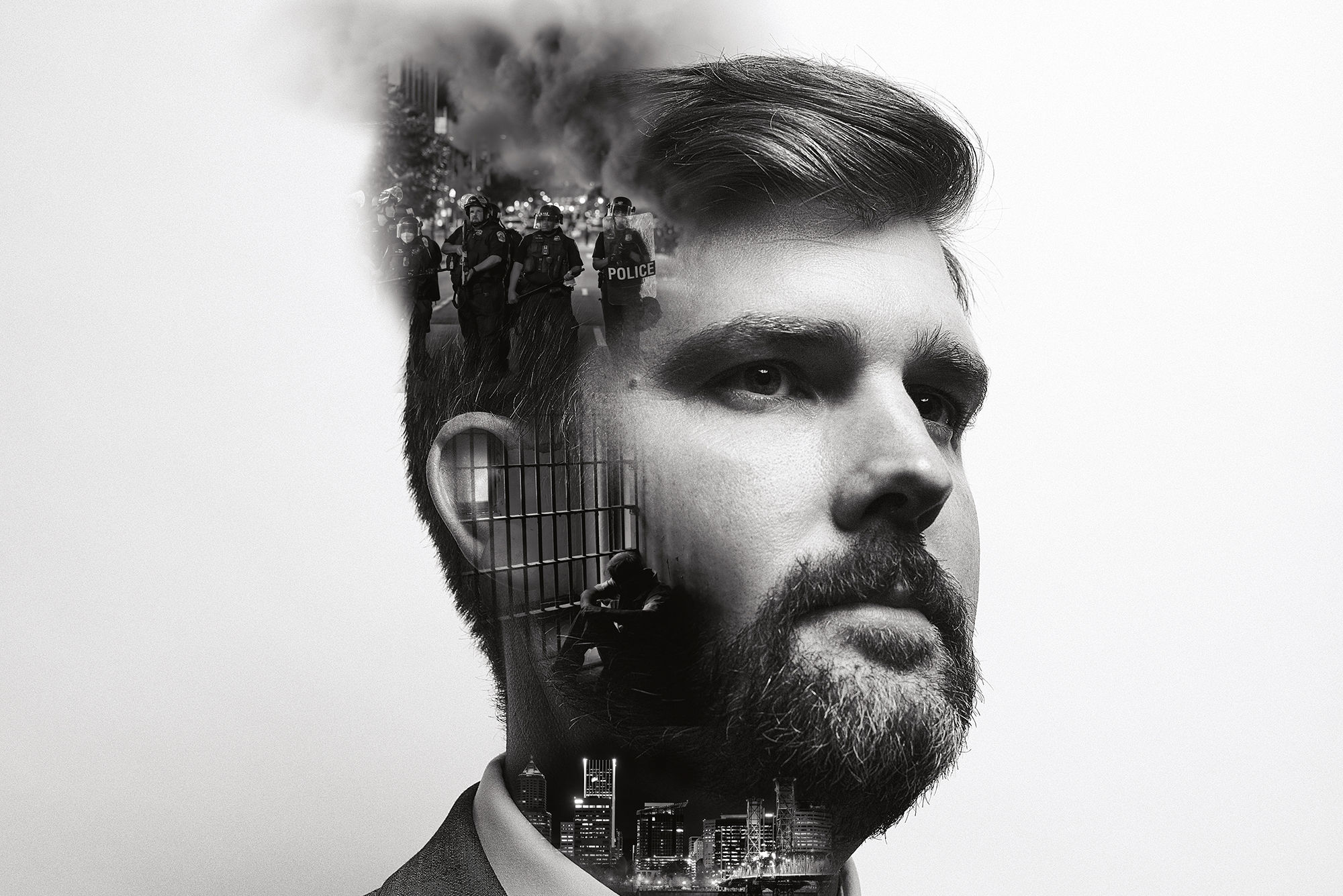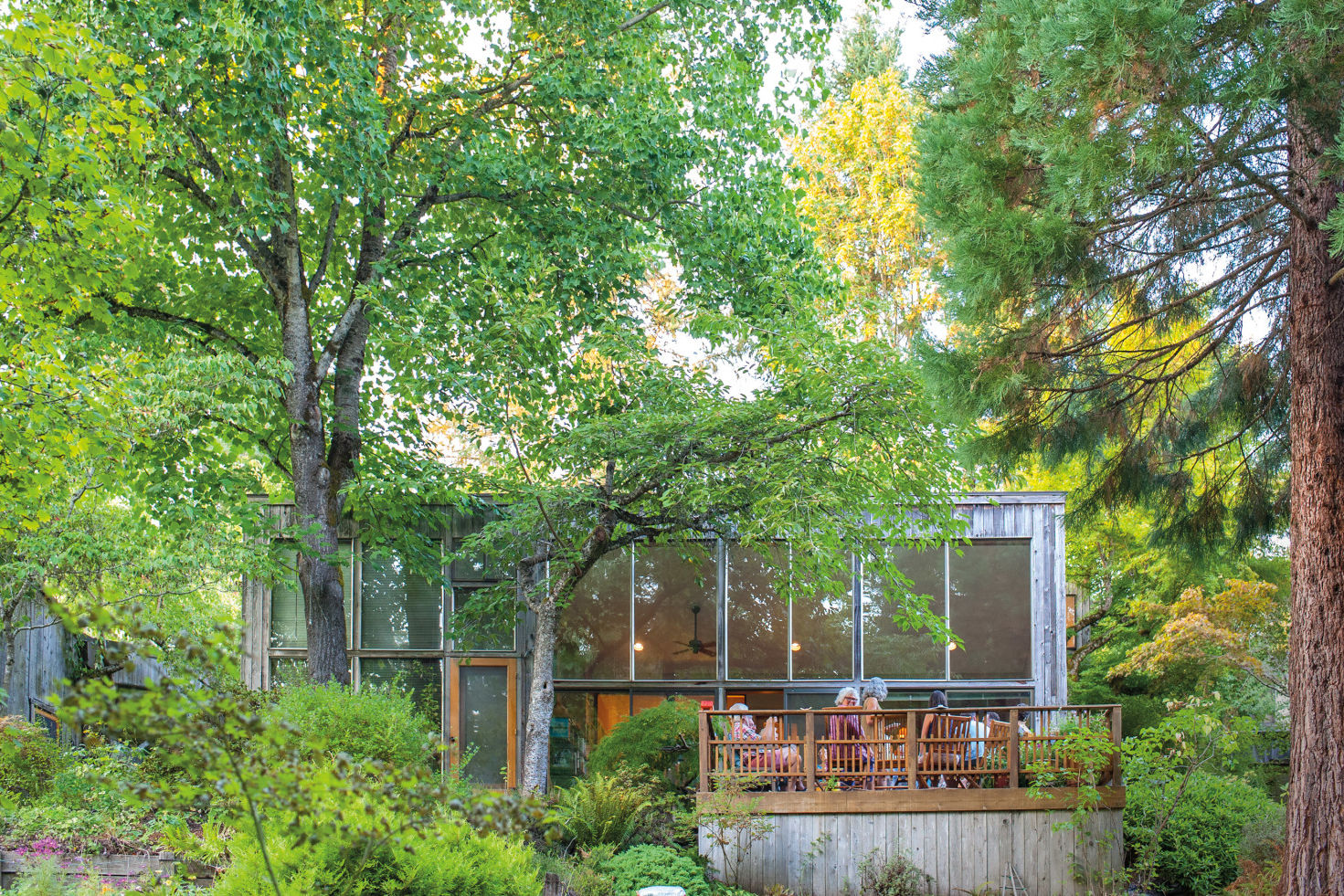
Inside Portland's Oldest Cohousing Community
As the residents of Sunlight Holding Co gather for dinner, the vibe is as balanced as day and night on the vernal equinox. At the end of a long afternoon, more than 30 residents, old and new, trade stories of the past and aspirations for the future. Swapping cheeses and dips on a deck, they gossip about the facilitator they hired but, as it turned out, didn’t really need. (One resident suggested the facilitator was trying to solve problems that didn’t exist.)
On a south-facing forested hillside rising from a creek, this cohousing community has evolved since its first 15 families arrived in 1979. Back then, children outnumbered adults in the shed-roofed, cedar-board-and-batten-clad enclave. They grew up and moved on, followed by their parents. Newcomers showed up, and now kids—just eight of them—are filling the air with hollers and the paths with toys. Meanwhile, “The Community”—a term all residents imbue with the authority of a proper noun—has remained strong and mostly conflict-free. “It’s not as if everyone is my close friend,” says Stephanie Sussman, who arrived at Sunlight with husband Stephen in 1982, sold her unit to their son in 2000, then bought it back in 2009. “But there isn’t one person who wouldn’t be there if I needed them.”
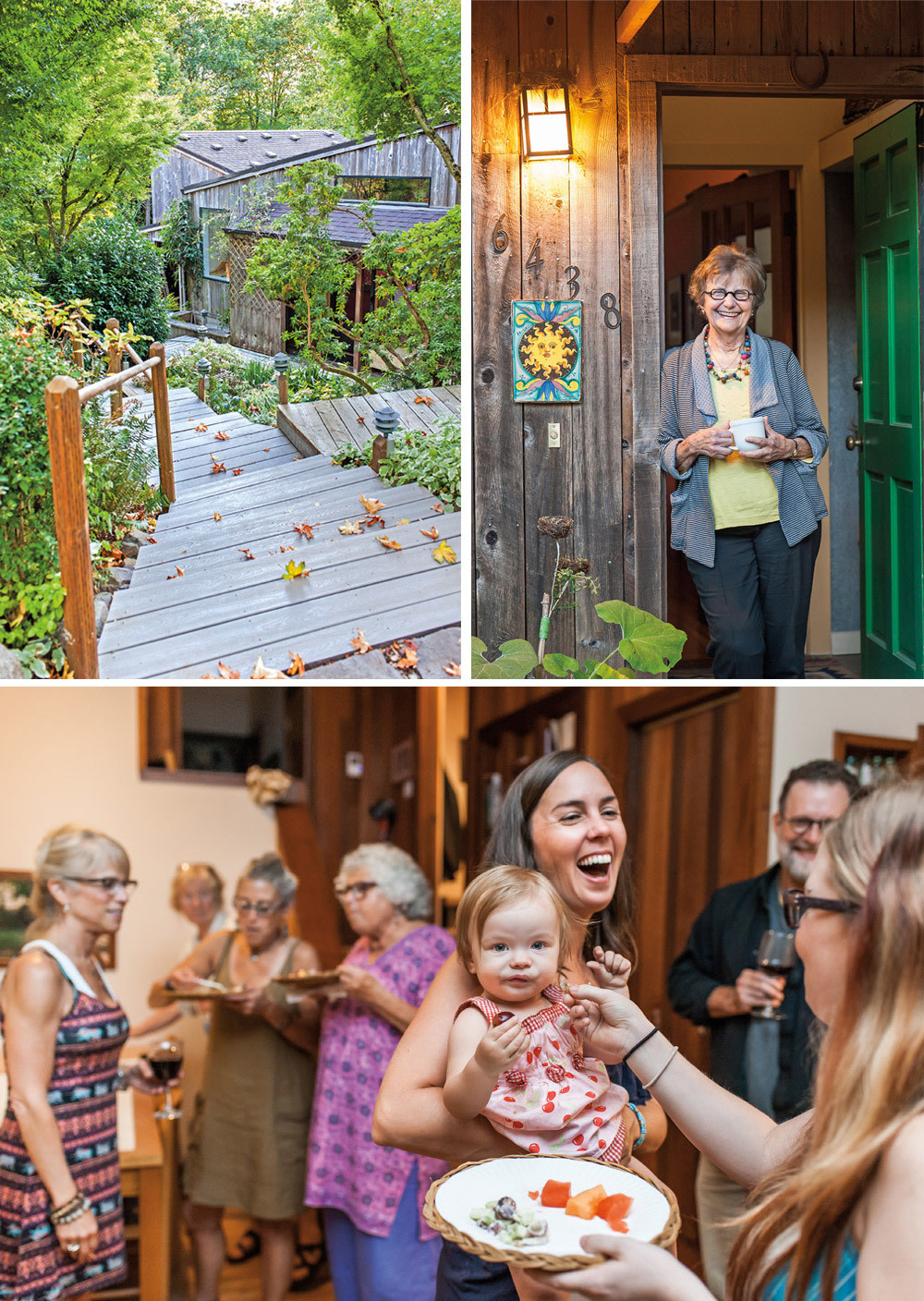
Image: Aubrie Legault
Cohousing’s growing appeal trades on concerns and aspirations that are part ’60s counterculture, part ’00s “sharing economy,” and bound into the American DNA all the way back to Plymouth Rock. In various ways, people who embrace cohousing share space, make decisions collectively, and otherwise try to meld community with the private life of home and hearth. The Washington state–based Cohousing Association lists more than 100 cohousing communities nationwide, with more than 80 under way. Locally, they range from mixed-generational developments like Trillium Hollow near Cedar Mill, started in 1998, to newer, übersustainable tracts like Buckman’s recently completed Ankeny Row.
Sunlight has proven remarkably durable among such experiments, but has also steered away from the ideology that sometimes drives cohousing. “We never started with an ‘ism’ or a shared belief,” says cofounder Alice McCartor, a retired social worker. “Nobody came seeking a leader. We were all middle class and relatively successful. We wanted nothing other than the fun of sharing.”
The idea for Sunlight began in a series of potluck dinners among a close-knit group of young families living in what cofounder Dorothy “Dot” Dixon calls “the liberal bastion” of Willamette Heights. At the time, most were members of Lifespring, a ’70s-era consciousness-raising group. But Dixon, like McCartor, now laughs about their long-ago faddishness. In retrospect, both agree Lifespring was only what brought them together—not what inspired them. “We wondered why we needed these big houses,” Dixon recalls. “We imagined that we could pool resources, that maybe we didn’t need 15 lawnmowers. But we didn’t want too many rules.” Dixon still recalls one founder’s spontaneous manifesto with a chuckle: “I don’t want to live anywhere where I have to ask to fart—this is supposed to be fun.”
Two architects—John Maslin and William Church—were part of the group, both of them interested in passive-solar design. They secured a 15-acre site off of NW Skyline Boulevard, sold off seven acres, and made plans to cluster their homes on five acres to keep the forest and the creek running through it pristine. The architects took some inspiration from land-hugging, barnlike simplicity of the Sea Ranch, the iconic, ’60s-era coastal California community designed by Charles Moore, Lawrence Halprin, and others. They lined up 15 homes in two rows along a main street they dubbed “Lois Lane.” They built a simple “great hall”—ceiling vaulted, of course—for monthly potlucks and other gatherings, but also equipped with a guest room and a workshop. Residents share tools, an exercise room, and a wood shop. Each unit is freestanding, fronted by a two-story solarium with concrete floors that absorb the winter sun’s warmth. Vents beneath draw air into other rooms.
From their first brainstorming sessions in 1977, the founders made “decision by consensus” a bedrock rule. One of the earliest of many debates was over the homes’ exterior colors. “There were the grays and browns,” recalls Dixon. “We finally just decided to let the architects decide. We got gray.”
Officially, a condo board governs Sunlight. But Sussman says that’s mostly to satisfy banks loaning to buyers. One longtime resident, an accountant, keeps the books. The board meets only to manage projects and share concerns. The only other regular meeting is the Fun Committee, which arranges monthly dinners, birthday and anniversary parties, and two annual solstice parties. All concede that the process can be agonizing but agree they wouldn’t have it any other way. “It allows everyone to be a creator,” says McCartor. “New families come in and bring new energy. We go down one road with one group, another with another.”
Perhaps no new residents have pushed through greater changes faster than Brooklynites Michael Wheeler and Linda Brown, who, with kids Ryley, 11, and Alice, 8, bought into Sunlight after looking at pictures online. Brown, a telecommuter to New York’s American Museum of Natural History, introduced the Audubon Society’s “Backyard Habitat” program to the Sunlight community, earning her own certification while encouraging others to do the same. Wheeler, an urban winery co-owner, spent months negotiating support for a community-owned tree house. Despite planning to locate it well away from the homes, hiring noted tree house designer Ian Weedman, and building it at his own expense, consensus took months. “Nothing is just embraced,” says Wheeler.
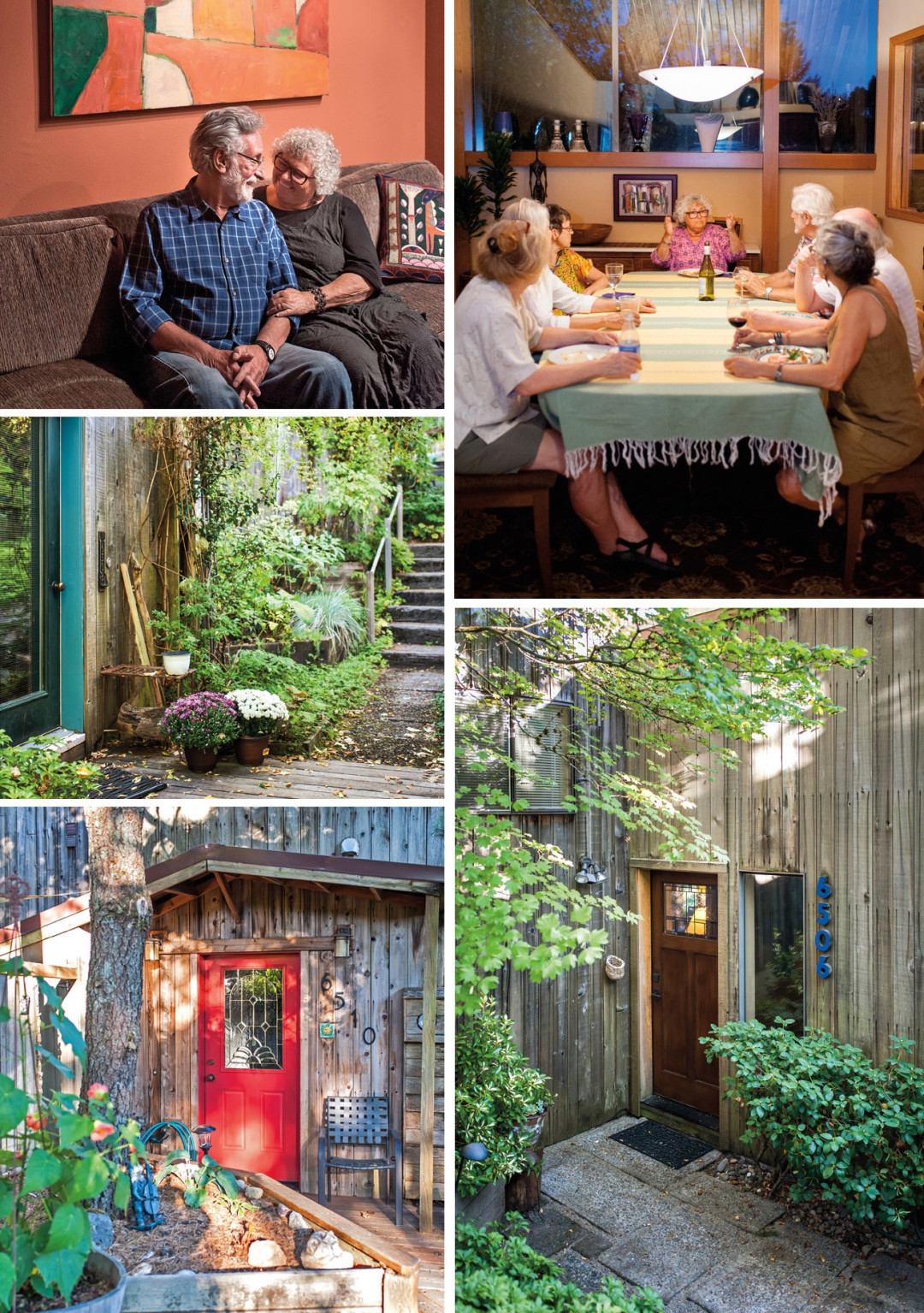
Image: Aubrie Legault
Longtime residents recall the decision that most challenged the consensus ideal: trees. Despite the community’s design and name, over the years tree growth had shaded many homes’ passive solar performance and access to natural light. But trees are a communal property, and the anti-cut contingent won. Frustrated, one family left—a rare break in a near flawless record of finding a path, however hard, for all.
Yet, unlike some cohousing communities that vote, up or down, on aspiring residents, anybody can buy a unit at Sunlight. Recent prices have hovered around $380,000 for a three-bedroom unit, with monthly fees at a minimal $130. The residents span the spectrum from retirees like McCartor and Dixon to couples with children to a single mom. “There seems to be a natural selection,” says Dixon.
For all the interactivity implied by the label “cohousing,” Sunlight feels more like a resort than a commune. A parking lot and cluster of individual garden plots sit near the street well above the units. Front doors face the steps that meander down the hillside, each offering the only departures the bylaws grant from the gray cedar cladding: reds, blues, and browns, house numbers in wildly different fonts, knickknacks like tiled balls, metal flowers, Celtic figurines, and, in one case, a very large American flag. (“When it first went up,” says Stephanie Sussman, “a lot of us went, ‘Oh my. Nobody’s done that before.’”)
Annie Scott, who joined Sunlight last year with husband Tim, a retired Oregon Symphony cellist, sums up the ethos: “It’s cohousing for introverts.”
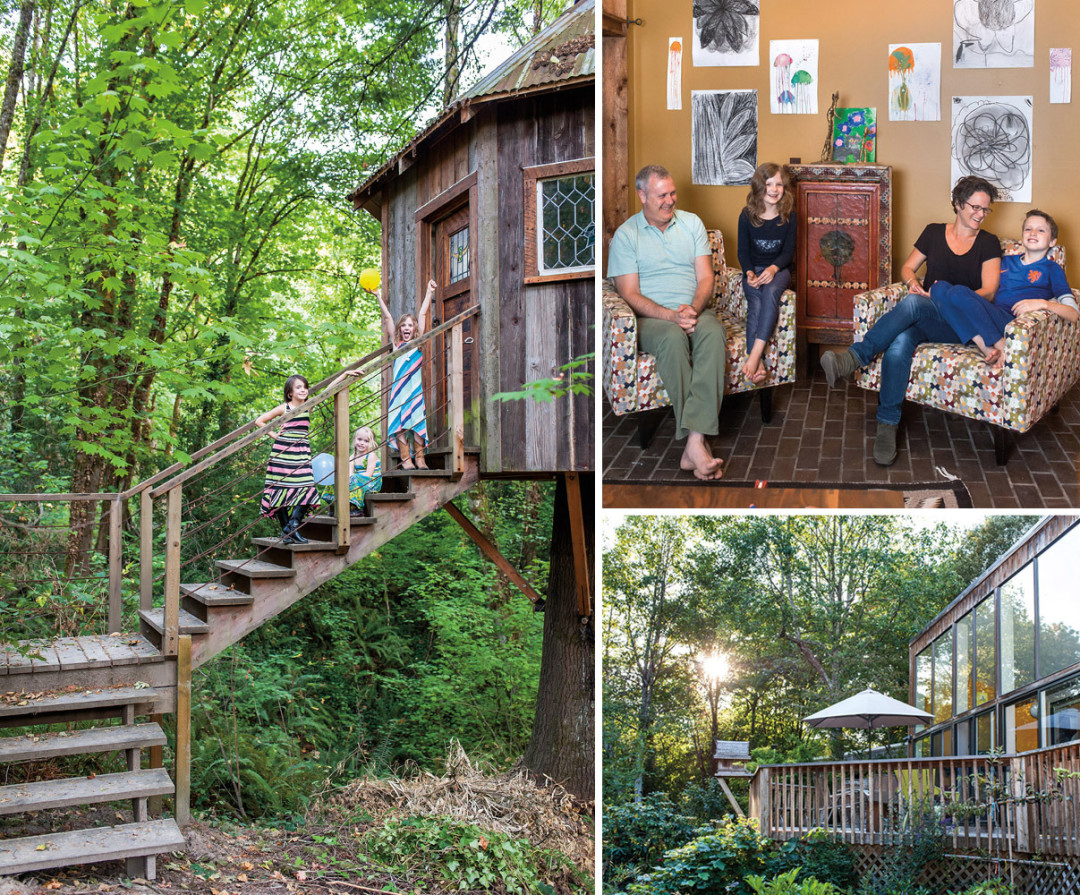
Image: Aubrie Legault
At the monthly potluck dinner, youthful yelps intermingle with adult murmurs. “I feel so fortunate to live with people of different ages,” says Dixon. “There’s something creepy about everybody being the same.”
Just steps from the well-worn teahouse, the new tree house, and a freshly installed zip line, a recent addition designed for the future stands: a circle of 15 stone slabs, deeply engraved with simple runes, representing each household. For newcomers, old-timers, New York sophisticates, and natives alike, Sunlight’s easygoing architecture seems designed for a long horizon.
“Everyone moves on from this planet,” says Wheeler. “But the community? It wants to go on for generation after generation after generation.”



